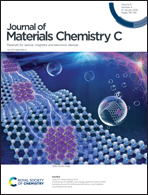Emission behavior, enol–keto tautomerism and bioactivity of hydroxy-substituted cyclic chalcone derivatives†
Abstract
Herein, a series of hydroxy-substituted cyclic chalcone derivatives 1–3 are synthesized. Bulk single crystals with bright multicolor emission are cultivated and their molecular packing structures are deeply investigated. The hydroxyl substitution endows these compounds with intrinsic enol–keto tautomerism character. Interestingly, owing to the conjugation effect and intramolecular hydrogen bond, the enol form is more stable than the keto form and thus dominant in solution. And this also leads to pure enol structure in the crystalline state. Moreover, it is found that enol–keto tautomerism is affected to an extent by the solvents and temperature. Increasing the temperature or solvent polarity is conducive to the keto structure. Theoretical calculations are well consistent with the experimental result, which further reveals the evolvement of enol/keto structures. Additionally, this type of chalcone displays high potential as a multifunctional fluorescent probe as demonstrated by cell imaging and apoptosis analysis. These findings would not only have great importance on disclosing the structure–property relationship of chalcone-based organic fluorophores but also provide a simple strategy for designing multicolored single crystals.



 Please wait while we load your content...
Please wait while we load your content...